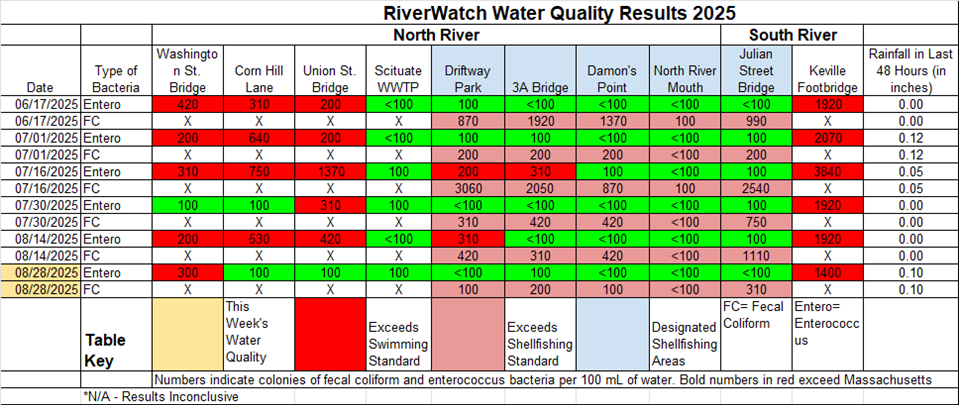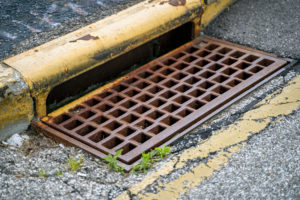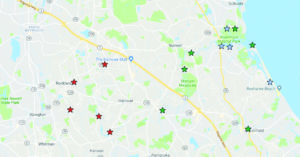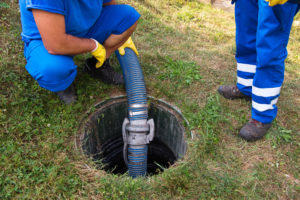On Thursday, August 28th, we conducted RiverWatch Water Quality Monitoring at 10 long-term monitoring sites on the North and South Rivers with citizen science volunteers. This year, we will be reporting our biweekly water quality results on this Water Quality Monitoring web page. We share this data with the public with a few important caveats; we are not a regulatory agency and these data are only a snapshot of the water quality at the time they were taken, which was several days ago. Rain and other polluting events can impact the quality of the water at any time. For example, please take note that these results represent conditions on 8/28 prior to short-lived but heavy rain events on 8/29.
The purpose of the RiverWatch Water Quality Monitoring program, which began in 1994, is to determine whether or not the sites along the North and South Rivers have exceeded bacterial colony concentration numbers for Massachusetts’ swimming and shellfishing standards. We use these data to document the long term health of our waters, to inform government agencies on the quality of our waters and advocate for improvements where needed.
Enterococcus samples were collected at ten sites along the North and South Rivers, while fecal coliform samples were collected in five shellfish growing areas (none of which are open at the moment for harvest). According to Massachusetts’ swimming standards, Enterococcus levels may not exceed 104 cfu per 100mL of water sampled. The Mass. Division of Marine Fisheries shellfishing standard is 14 cfu per 100mL of fecal coliform.
For samples collected on August 28th, enterococci bacteria levels passed Massachusetts’ swimming standards at 8 of the 10 locations. The Washington Street Bridge and the Keville Footbridge exceeded the standards.

This was our final round of sampling for the Summer, thank you to all of our volunteers this summer for conducting the sampling and analysis! We would like to extend our gratitude to the Cohasset Center for Student Coastal Research for allowing us to use their laboratory for sample processing, as well as to the Norwell Women’s Club and our members for providing funding for this program.

RiverWatch
RiverWatch is a volunteer-driven effort that monitors local waters for compliance with both swimming and shellfishing water quality standards. Since 1994, we have monitored bacteria and other water quality indicators like temperature, dissolved oxygen, salinity, and conductivity at ten sites in the North and South Rivers every other week from June through August.
 Since we have started sampling, the percent of bacterial samples that have exceeded the swimming standard each summer has decreased, from 22-24% in the 90s and 2000s to 15% in the 2010s and 2020s. This is due to a reduction in stormwater pollution as well as increased sewering along the South River that reduced wastewater pollution.
Since we have started sampling, the percent of bacterial samples that have exceeded the swimming standard each summer has decreased, from 22-24% in the 90s and 2000s to 15% in the 2010s and 2020s. This is due to a reduction in stormwater pollution as well as increased sewering along the South River that reduced wastewater pollution.
 In 2017 we started testing enterococcus bacteria at all ten RiverWatch sites. In 2024, only three sample sites didn’t meet the swimming standard (35 cfu/100mL), those sites including the Washington Street Bridge, Cornhill Lane, and the Union Street Bridge. Unfortunately, the geometric mean of fecal coliform exceeded the shellfish standard at all marine sites.
In 2017 we started testing enterococcus bacteria at all ten RiverWatch sites. In 2024, only three sample sites didn’t meet the swimming standard (35 cfu/100mL), those sites including the Washington Street Bridge, Cornhill Lane, and the Union Street Bridge. Unfortunately, the geometric mean of fecal coliform exceeded the shellfish standard at all marine sites.
TEMPERATURE
 Measuring temperature is a part of almost all of our monitoring efforts. We were curious whether we could detect any increases in temperature due to climate change in our RiverWatch temperature record, which is the most reliable and consistent. There were no trends looking at all the data pooled together over time, nor looking at each site’s data for an entire summer over time. However, we did find a trend in the August water temperature at the Washington St Bridge site on the North River in Pembroke and Hanover. We conduct these surveys to track new and existing invasive species that impact intertidal and subtidal ecology by occupying niches belonging to native species. August water temperatures at Washington Street Bridge have increased an average of 0.0567°C annually or 1.13°C from 2004-2024
Measuring temperature is a part of almost all of our monitoring efforts. We were curious whether we could detect any increases in temperature due to climate change in our RiverWatch temperature record, which is the most reliable and consistent. There were no trends looking at all the data pooled together over time, nor looking at each site’s data for an entire summer over time. However, we did find a trend in the August water temperature at the Washington St Bridge site on the North River in Pembroke and Hanover. We conduct these surveys to track new and existing invasive species that impact intertidal and subtidal ecology by occupying niches belonging to native species. August water temperatures at Washington Street Bridge have increased an average of 0.0567°C annually or 1.13°C from 2004-2024
Download the 2023-2024 Annual Citizen Science Monitoring Report here.




